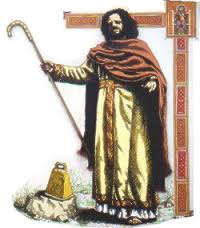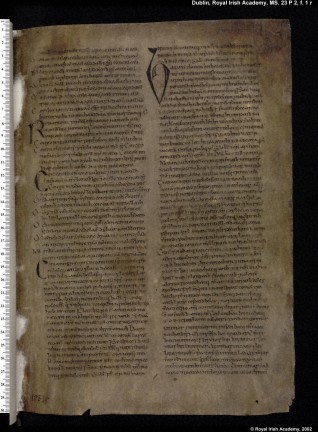
Summary: St Fintan. There seem to have been at least two Fintans if not three in the ancient Irish Church – one associated with Clonenagh in Co Laois and another with Taghmon in south Co. Wexford, who is also called St Munnu. A possible third is associated with the church in Doon in Co Limerick.
Patrick Duffy looks at some of the traditions about the second Fintan, called Munnu.
Early Formation
 Munnu was a saint of the Cenél Conaill branch of the Northern Uí Néill. His father was Tulchán, whose family was connected with the barony of Corkaroe in Co Westmeath and his mother was Fidelma, also of the Uí Néill. He studied under Comgall of Bangor and under Colmcille at Cleenish in Lough Erne under Sinell.
Munnu was a saint of the Cenél Conaill branch of the Northern Uí Néill. His father was Tulchán, whose family was connected with the barony of Corkaroe in Co Westmeath and his mother was Fidelma, also of the Uí Néill. He studied under Comgall of Bangor and under Colmcille at Cleenish in Lough Erne under Sinell.
A Monk at Iona 597
Adamnan tells how Munnu was about to sail for Iona to enter Columba’s community when he met two Iona Monks. Asking if Columba was well, they replied he was very well, since he died a few days earlier and was in heaven. They all sat down and wept bitterly. Munnu went on to Iona, but was refused entry by the new abbot Báithéne. Columba had decided before his death that Munnu should not enter Iona, on the grounds that he had the capacity to form his own community.

St Munnu’s Church. Co Westmeath.
A Foundation near his Home
Back in Ireland Munnu founded a monastery at Taughmon near Crookedwood in Co Westmeath, where there is still the ruin of a St Munnu’s Church.
Kilgavan, Co Wexford
After that he went south into Wexford where he lived for a time with the familia Comgalli at a monastery called Ard Crema, which has been identified with a site at Kilgowan or Kilgavan near Carrick-on-Bannow. He must have dealt harshly with the monks here as after being their abbot for twelve years they asked him to leave. He didn’t go without calling down a curse on them.
Teach Munnu (Taghmon), Co Wexford
He then moved to a place called Achadh Liathdroim and it was here that he remained for the rest of his days and he ruled with a rod of iron. It was later named after him as Teach Munnu and housed about 230 monks. Toward the end of his life Munnu was afflicted with leprosy, which was common enough in medieval Ireland.
Figure of Controversy

The Martyrology of Tallaght
Munnu was a figure of controversy in the dispute about fixing the date of Easter. A synod held at Mag Lée near Durrow in 630 agreed to accept the Roman way of computing Easter, but Munnu held out for the traditional Irish way. This angered the abbots who had made the agreement. Cummian, abbot of Durrow, writing in 632 to Segéne, sixth abbot of Iona, described Munnu as “a certain whited wall” (paries dealbatus).
This referred both to his leprosy and to his hypocrisy in pretending to preserve the tradition of the elders.
The “hard men” of Irish Hagiography
According to the Martyrology of Tallaght, Fintan of Clonenagh, who had the name of being the “hard man” among the Celtic abbots, is said to have made a pact of unity (oentas) with Munnu – another hard man – so that the name of each was given to the other, in commemorationem societatis: Fintan took the name Munnu or Munda as one of his epithets and Munnu took on the name Fintan. Both enjoy the dubious reputation of being the “hard men” of Irish hagiography.
____________________________________
******************************
Memorable Sayings for Today
Contradictions put us at the foot of the Cross,
And the Cross of Jesus lifts us up to heaven.
~ St John Vianney ~
******************************